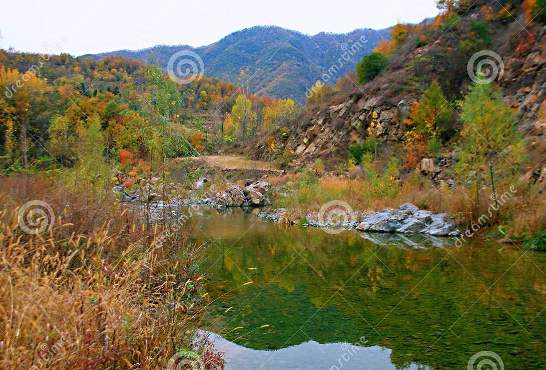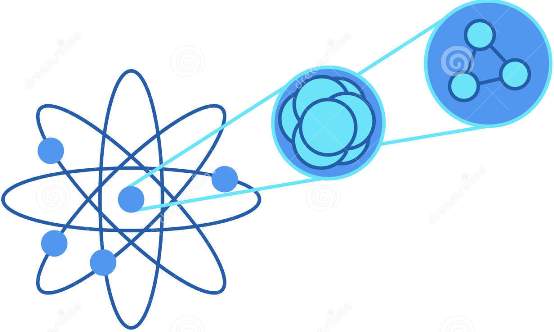The hinterland of Particle Physics

Introduction
Particle Physics is collectively an effort to study the exciting world of subatomic particles and the nature of their interaction. By subatomic we mean anything that happens within the atom or below and not above. The implications could cover as much above, as would be entailed by the precincts of natural laws.

eg If a process corresponds to as big a size as is a micro-gram, its evidently not subatomic size in length dimension. The subatomic size by its definition of length scale would correspond to a femto-meters. But the given process could be subatomic, while the result of having a size of micro-gram would not be.
Hence while the size of the subatomic entity can roughly be considered to be a femto meter, nonetheless a particle of the size of pico-meter might find relevance in the study of subatomic processes due to such eerie connections. For another matter a micro-gram is the unit of mass and not that of magnitude of distance.
Particle Physics is basically a field of Quantum Mechanics and still, further advancement of the research fields, such as the Quantum Field Theories. A micro-gram would correspond to some of the highest known limits of energy such as is carried by the popular “Oh My God Particle“. As a result, such massive amounts of energy, would have their basic implications to be understood from the study of Quantum Mechanical processes. Naturally enough the subatomic processes would lend themselves to the behavior of such massive physical entities.
But that’s just a higher order in energy or mass implications of Particle Physics. We basically concern ourselves with the much smaller size of distance, mass or energy, in the study of Particle Physics.
Units in Particle Physics
The all very known entities that we study in Particle Physics are the Quarks, electrons and the mesons. In Particle Physics the basic unit of suitability of physical quantity draw heavily with the usage of natural units as well as what can be aptly called the subatomic physical units. In natural units, Planck’s constant has a value of unity. Similarly speed-of-light c, and universal gravitational constant G also have a value of unity: .
The other physical constants whose value is 1 in natural units are permittivity of free space (
), permeability of free space (
), impedance of free space (
) and Boltzmann constant (
).
But the subatomic physical units are that of eV (the electron volts), KeV, MeV or GeV or as we have stumbled upon in recent decades, the TeV. Each with a 1000 times more quantity than its predecessor. So a KeV is 1000 times more quantity than the eV and the MeV is 1000 times more quantity than the KeV.
Caution need not be thrown out of the window as it is a natural question as to why we say “more quantity” than “more energy”. Isn’t eV the units of energy? Yes, its the unit of energy, a subatomic physical unit of energy. But as mentioned above, in Particle Physics the natural units play a heavy role. So, speed-of-light, c = 1.
While MeV is eg the unit of energy, MeV/c is the unit of momentum. But c = 1 and this degenerates into saying MeV is also the unit of momentum, as well as it is the unit of energy. In a similar argument the unit of mass is also MeV. So its not really lose talk, but constrained by the conditions of consistency, which the scientists would have in mind, if they were to use, MeV for all of the variables: energy, mass and momentum.
Only caution is we need caution, so in other units than the combination of subatomic and natural units, there would be a wide chasm of separation between energy, momentum and mass, each subsequently down by one order of speed of light value in those units.
Equivalence of mass, momentum and energy
The above brings Einstein’s relativistic equations into a simpler form and helps one to see why someone would proclaim “mass and energy are equivalents“, in the same breath “energy and momentum are equivalents“, as, in a particular situation all energy does not go into mass, but some of it goes into momentum as well.
So the Einstein equation of mass energy equivalence is; which can also be written as E = m, in subatomic-or-natural units. The equivalence is readily seen. This is the reason why Particle or Nuclear Physicists would speak of 1 MeV of mass or 3 MeV of mass, as well as they would speak, 4 or 5 MeV of energy, MeV is now a bonafide way to represent both mass and energy. The equation E = m also necessitates that 3 MeV of energy is also exactly same as 3 MeV of mass.
But in another situation, there are other equations. eg The Einstein’s relativistic equation known as momentum, mass, energy or simply momentum-energy relation, or
is the recognition of the equation in other physical units of;
.
The simpler form in subatomic-cum-natural unit gets rid of square of c from momentum and 4th of power of c from mass. Now E, m, p form a Pythagorean triangle among themselves. Hence how much of energy is mass and how much of energy is momentum is constrained by the Pythagoras relation among them.
Nevertheless we say that energy is equivalent to mass and energy is equivalent to momentum. Just that there is a distribution for exactly how much of energy is equivalenced to mass and exactly how much of it is equivalenced to momenta.
Advance formulations of Particle Physics
Particle Physics is at the forefront of physics, in theory, experiment and research, which heavily draws into technological advancements of instrumentation and software. But it also lines up with great deal of work in statistics, computation and modeling of physical systems.
There would be a very few other branches of science which would be a confluence of all that one learns through one’s training as a science undergraduate and graduate. Its a bit more widely formulated than most. But it asks for the most expertise driven and speciality driven training and application than most. Its for that reason at the forefront of discovery and conceptual expansion of the fields of research.
All the nature of particle physics draws directly from the formal frameworks of Quantum Mechanics and the Quantum Field Theories. Hence just with the training of undergrad advance physics it isn’t enough to get into the mode of making discoveries or even master the nitty-gritties of Particle Physics. One needs specialized training in the graduate programs of some of the well equipped labs and-or research and academic universities. This prepares the future scientists extensively and intensively.
So what are the formal ground work of Particle Physics?
The Basic tenets of Quantum Mechanics
Wave function
The very basic formulation of Quantum Mechanics is that every physical system must be describable as an infinite set of quantum wave functions, also called as state vectors, wave vectors or Eigen States. Each wave function is a complex valued function such that it satisfies an equation of motion. The equation of motion can have different formulations giving rise to valid and equivalent descriptions of the system. eg Schrodinger’s Equation is a differential equation of motion that at the same time describe a system of particle as well as it describes a system of waves.
These equations of motions are also called wave equations, but they actually pertain to wave-particle mechanics. Hence Quantum Mechanics is sometimes called as wave mechanics, but its a loosely connotation for wave-particle mechanics in general.
The solution to these wave-particle equations of motion are the eigen functions or eigen states, which are infinite in number as mentioned above. Hence an usual day for a particle physicist involves the computation of integrals among other equations.
These wave-functions, the solutions to the differential equation of motions, completely describe the behavior of the quantum mechanical system. What we obtain from the wave functions are called eigen values. An eigen-value is a measurable quantity of the immeasurable wave function.
But the immeasurable wave function carries in it all necessary information of the physical system in a consistent fashion. So, if I need energy I ask the wave function and it supplies me the value of energy. Infinite number of discrete or continuous values of the energy are available, from the infinite base or eigen states, they are called as eigen value.
But the wave function or its solutions, the eigen functions, not only give us energy, but also any physical quantity that we formulate to be consistent with the formalism of physics. Hence we can obtain the momentum, mass, spin, angular momentum and so on for the system of particles. They can all be discrete or continuum under certain situations.
An act of measurement takes away all arbitrariness of a physically valid theory and gives handy numbers on anything of concern. By carrying out measurements and relating them to theory, eg, we can say whats the mass of a new found particle such as Higgs Boson and whats the energy and momentum distribution of any particle such as a meson or proton, in a given possible reaction.
The world of Particle Physics, a highly eulogized forum of theory, experiment, and intellectual contents of relevance to Particle Physics spans the scientific data bases in the world today. The PDG short for Particle Data Group is an organization that has as much role in the community of Particle Physics as perhaps the United Nations in the committee of nations.
Their published voluminous work, that is released every two years, known as; PDG book, compiles all relevant and discovered facts and concepts and updates every two years. If one has never come across a copy of such, one is not a particle physicist. In addition if one has come across it one must know how to use it.
Application of wave function
The system of particles evolves from one state of wave functions to another, the initial configuration of a system of particle’s phase space corresponds to an “initial state particles” and the evolved final configuration corresponds to the “final state particles”. For such one often finds phrases such as “initial state radiation” or “final state radiation” in particle physics that signifies the release or absorption of a bunch of photons.
Since wave function is a complex valued function, it has its own amplitude and its own phase. Amplitude and phase are what define a complex number. Its the amplitude which when squared gives the “likelihood” of a particular situation. That is one might compute using the best of the best of supercomputers (or at-least a highly sophisticated set of high computing power computers) what is the probability that an electron will be released in a nuclear beta decay, under a given situation, lets say in a MRI device in a medical application, and that would be the expertise of a particle physicist.
One can hire particle physicists with a lot of confidence in medical physics, that some substantial progress can be made in the understanding of the functions of these instruments, so vital for our survival. Particle Physics is not just an esoteric branch of monopoly seeking brats, the particle physicists can actually achieve something via Monte Carlo simulation of a CET oscilloscope or theoretical computation of a nuclear physics reaction. But at the base its the ability to formulate and compute the amplitude whose square gives us meaningful predictions of the behavior of such systems and processes.
Further elucidation of nature of wave functions
The amplitudes of the complex valued wave functions are amenable to whats called superposition principle. If multiple particles are present they interfere like waves, its because the system of particle’s amplitudes are waves. They add up linearly, for different possible particles and different possible trajectories.
Life becomes simple because of such linearity. The alternative trajectories are therefore simply the various paths possible for the evolution of the particle configuration, with different likelihood for each path or possibility, characterized by the detail nature of the amplitudes.
If A goes to B and C, the amplitude of state of A determines, based on various factors such as energy, mass, momentum and spin of A the likelihood that it will go to B and C with such and such probability, and such and such possible values of mass, energy, spin and momentum.
That’s because whats possible is governed by the physical laws and formulated into the behavior of the wave-function and therefore the amplitude. Thus the amplitude tells us exactly how many number of certain particles will be produced and so on. The amplitude and wave functions are describable in terms of relativistic laws, since particles in the subatomic realm move at a significant fraction of speed of light. This is ensured by whats known as co-variant form of the amplitudes.
Next we will discuss what are the basic values measured in particle physics studies.

Leave a comment